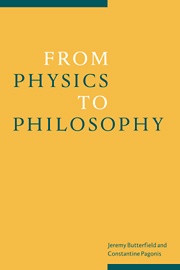Book contents
- Frontmatter
- Contents
- List of contributors
- Preface
- Introduction
- 1 Locality and the Hardy theorem
- 2 Beables in algebraic quantum theory
- 3 Aspects of objectivity in quantum mechanics
- 4 The ‘beables’ of relativistic pilot-wave theory
- 5 Bohmian mechanics and chaos
- 6 Strange positions
- 7 From metaphysics to physics
- 8 Models and mathematics in physics: the role of group theory
- 9 Can the fundamental laws of nature be the results of evolution?
- Bibliography of the writings of Michael Redhead
- Index of names
- Index of subjects
5 - Bohmian mechanics and chaos
Published online by Cambridge University Press: 23 December 2009
- Frontmatter
- Contents
- List of contributors
- Preface
- Introduction
- 1 Locality and the Hardy theorem
- 2 Beables in algebraic quantum theory
- 3 Aspects of objectivity in quantum mechanics
- 4 The ‘beables’ of relativistic pilot-wave theory
- 5 Bohmian mechanics and chaos
- 6 Strange positions
- 7 From metaphysics to physics
- 8 Models and mathematics in physics: the role of group theory
- 9 Can the fundamental laws of nature be the results of evolution?
- Bibliography of the writings of Michael Redhead
- Index of names
- Index of subjects
Summary
Introduction
It is a pleasure to be able to contribute to this volume in honour of Professor Michael Redhead. In the foundations of physics community, his influence has been felt both through his Incompleteness, Nonlocality and Realism (1987), which has largely denned the terms of discourse in this field for the last decade, and by the new ‘Cambridge School’ of the philosophy of physics that he established there during his Professorship in the History and Philosophy of Science Department. Michael Redhead's work illustrates well what has always seemed to be a central tenet of his: that philosophers of science should use the conceptual background and the mathematical formalism of modern, successful scientific theories – especially quantum mechanics and quantum field theory – as a guide to understanding the ontology of the world (Redhead 1983, 1990) and to reexamining traditional philosophical questions (French & Redhead 1988; Redhead & Teller 1991, 1992). In his Tarner Lectures (1995) he used this type of work to anchor a general position that can be characterized as structural realism, which holds that the structures – mathematical formalism, models, analogies – of a successful scientific theory eventually define the real, even as regards central, unobservable entities.
While Professor Redhead has done an outstanding job of pressing forward with this general programme, it remains arguable that he and some of his co-workers, who have, in the main, stayed within the framework of standard quantum theory and relativity, may have effectively bracketed a different and potentially fruitful alternative theory.
- Type
- Chapter
- Information
- From Physics to Philosophy , pp. 90 - 107Publisher: Cambridge University PressPrint publication year: 1999
- 3
- Cited by



